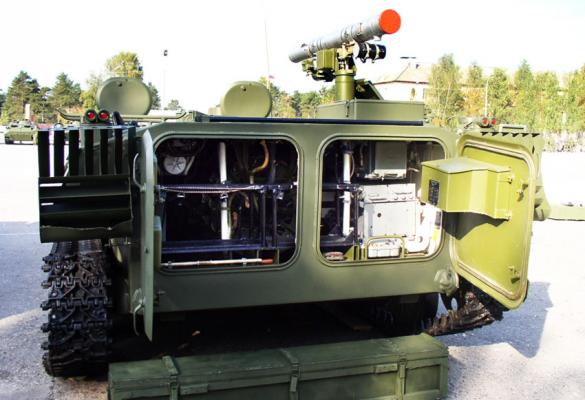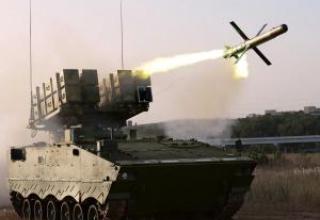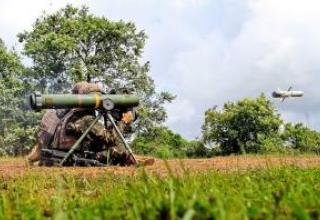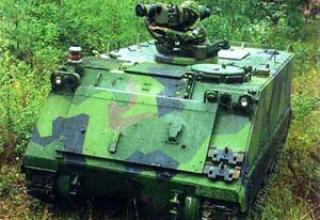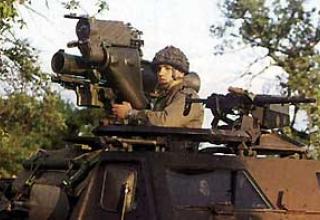The 9P149 "Storm-S" anti-tank missile system (ATC) is designed to destroy tanks, armoured personnel carriers and heavily loaded point targets. It was designed as a single weapon system for ground-based "Sturm-S" and airborne "Sturm-B" and was equipped with the first serial PTUR with supersonic flight speed. The complex is designed in modular design, which allows it to be deployed on any type of BMP, APC, tanks and helicopters of both Russian and foreign manufacture. It has a semi-automatic missile control system with the transfer of commands over a radio line. Original scientific and technical solutions on control equipment made it possible to shoot without reducing the probability of hitting the target in conditions of active counteraction by the enemy, that is, the key for such systems was solved the problem of interference protection of complexes from natural and organized radio and IR interference of different types.
It was developed in the mid-1970s in the Kolomenskoye Mechanical Engineering Design Bureau (KBM). Tests were completed in 1978, and in 1979 the self-propelled ATM "Sturm-S" with missile 9M114 was adopted for service by army and front units. Serial production was set up by Volsk Mechanical Plant.
The works on increasing combat capabilities of the "Sturm" PTRK began at the Mechanical Engineering Design Bureau, almost immediately after the complex was put into service. The creation of new missiles with increased power was chosen as the main modernization direction. First of all, the new missiles were planned to increase armor penetration (by equipping them with a tandem cumulative combat unit) and launch range. At the same time, the military has put forward a mandatory requirement - to ensure the use of new missiles with helicopters in service Mi-24 family and combat vehicles 9P149 self-propelled complexes. This setting of the task practically excluded the possibility of increasing the length of the new missile compared to the base model. All requirements were successfully implemented in the new missile 9M120 "Attack", the first modification of which was adopted for service in 1985. The main structural difference of the new missile was the use of a more powerful engine, which increased the range of fire, as well as a new tandem cumulated combat unit, which has a greater armor penetration. Improvement of "Sturm" complexes continues - a new family of missiles - 9M220 was created, which significantly increased the combat efficiency of the complex.
The "Sturm" SAM system was exported to dozens of countries, including countries of the Warsaw Pact, Cuba, Angola, Zaire, India, Kuwait, Libya, Syria, etc. The complex was successfully used during the combat operations in Afghanistan, Chechnya, Angola, Ethiopia, etc.
In the west, the missile was designated AT-6 "Spiral".
Composition:
The 9M114 multi-purpose guided missile (see description of 9M114) is used in the Storm-S complex. It follows the aerodynamic "duck" pattern. The main elements of the radio command control system are located in the tail compartment. At the rear end of the marching stage there was a source of infrared radiation fixed by ground or helicopter semi-automatic control equipment, as well as a radio antenna. In the transport position, the tail compartment was covered by four wing consoles. Arc-shaped wings - rectangular in plan, when viewed from the front curved in an arc towards each other, opened by a spring mechanism. The plane of the aerodynamic rudders is shifted by 45 ° in relation to the planes of attachment of the wings and at 90 ° - to the plane of the nozzle axles. To reduce the weight and dimensions of the rocket controls are made on a single-channel scheme. The rocket employs a solid-fuel dual-mode marching engine that provides high flight speed (up to 530 m/s). Control commands from the onboard control system were transmitted to the front bays by cables laid in a pipe running along the longitudinal axis of the missile inside the combustion chamber of the marching engine. The armor penetration of the missile is up to 650 mm.
A launch accelerator, an upper stage booster, was placed at the rear of the pipe of the transport and launch container, which was separated from the rocket when it was completed. The 9M114 missile was delivered from the manufacturer and operated by the troops in a fiberglass transport and launch container (GRP). The design of the transport container ensures that the missile rotates around its longitudinal axis during launch. The TPK provides a 10-year warranty period for the missile. The missiles were delivered in technological packaging - capping with the size of 1.93 x 0.33 x 0.73 m. In the process of serial production, the 9M114 family rocket was repeatedly upgraded to improve its combat efficiency, launch range, interference immunity, etc.
"Assault-S" can also be equipped with a guided missile 9M114F with a high-explosive warhead. This makes it possible to destroy enemy manpower and destroy long-term firing points and other engineering structures, including in mountainous terrain. Due to the appearance of dynamically protected tanks, the designers have now created a new missile with the 9M114M tandem warhead, which is competitive on the world market. The upgraded missile has an extended range and is capable of reliably engaging tanks behind the dynamic protection.
Missile guidance system - semi-automatic, radio command, with infrared tracking signal. Measurement of the missile's coordinates relative to the target sighting line is made by the direction finder of the guidance equipment. The direction finders for reception of an infrared signal of infrared radiator PTUR are built in sighting devices of helicopter or ground guidance equipment. High noise immunity of the "Assault" complex is provided by a narrow diagram of the radio antenna orientation and the relative short duration of the radio equipment emission cycle, as well as switching of five litre frequencies and two remotely controlled codes of control signals. It is also possible for a group of PTWCs to simultaneously use weapons in a limited space. In order to prevent the direction finder from capturing semi-automatic guidance equipment of a "foreign" missile, the signal of the PTUR infrared radiator is formed in accordance with the frequency and code of microwave impulses of radio control commands coming on board the missile.
While developing the ground version of the complex, there were some difficulties. In particular, pointing at the target was hindered by dust rising behind a flying rocket. During the flight 9M114 near the ground surface, in addition to dust sucking by the engine jet, the impact of the shock wave on the ground was also affected. At launches from helicopters this problem did not arise - guided by a method of matching ("three points") rocket gradually decreased, but mostly flew at sufficiently high altitudes. According to the results of the research carried out by the TsAGI specialists, the dust trail could be formed during the flight of the ATBM at the altitude of less than 6 m. To reduce the impact of undercarriage, the engine thrust was reduced to the level required on the marching section. The acceleration of the rocket took place on the section of the launch engine operation - a detachable accelerator, which worked mainly inside the transport and launch container. The missile's exit velocity from the TIC was 55 m/s. In addition, a special "Dust" mode was introduced in the ground control system of the missile (see diagram). When this mode is implemented, the missile flies at an altitude of more than 6 meters on most of its trajectory and only at a distance of 500 - 700 meters from the target enters the line of sight. This allows the operator to always see the object being hit, regardless of the weather conditions and the operation of the rocket's engines. At the maximum range of fire the accuracy of the PTUR control system, the self-propelled ATM "Sturm-S", does not exceed 0.6 angular minutes. It allows firing at any small armored targets, low-flying helicopters, including in hover and take-off mode. The maximum altitude of air targets (sea level launch) is 3000 meters.
Fighting vehicle (BM) 9P149 PTRK "Sturm-S" is made on the basis of multipurpose floating light armored transporter-tractor MT-LB. Its high traction, the presence of a tracked mover, low specific ground pressure allow the complex to be effectively used in various natural and climatic conditions, including deserts, mountainous terrain and off-road. The layout of the launcher (see the schematic) and other equipment make it possible for the crew of the combat vehicle to fire from an open position, an engineered shelter, as well as from the water surface when the MT-LB is floating (at a speed of up to 5 km/hour). Low silhouette of the tractor (roof height does not exceed 1.8 m) and low center of gravity allow its use on steep slopes. On the dry retarded ground the truck can climb steep up to 35°, roll up to 25°, 2.5 m wide ditch, vertical wall height of 0.8 m.
BM 9P149 is equipped with a system of crew protection from WMD. It includes a filtration and ventilation unit, a chemical and radiation reconnaissance device, as well as hull sealing devices. In addition, the anti-tank complex "Sturm - C" has communication facilities with a range up to 40 km and night vision devices.
The Storm-S" anti-tank missile launcher is automatically rechargeable, guided in two planes. The rejection of the launchers with multiple rails was determined by the ability to provide fast recharge relatively light installation with low moments of inertia, carried out over time, shorter duration of the missile to the target, which is usually at a long range. For the Storm-S complex, it was possible to achieve a firing rate of 3 to 4 rounds per minute. In the hiking position, the launcher is removed inside the hull, where the warhead mechanism (special rotating drum and gearbox) is placed. Twelve launch containers with missiles are installed on the drum spools. When firing, the PU captures the container and automatically switches to the combat position. The time from the moment the combat button is pressed until the missile leaves the transport and launch container is one second. After the shot is fired, the used container is thrown aside and the new TPK is automatically captured from the warhead and brought to the firing line.
Optical sighting device with built-in channel for tracking the missile's infrared radiator is placed on the left side of the vehicle roof. The task of the "Storm-S" complex operator is to superimpose the sighting mark on the target and hold it until the missile contacts the target. It provides firing of targets moving at flank speed up to 60km/hour with front speed up to 80km/hour.
The high combat capabilities of Storm-S can be achieved with the reliable operation of all its systems and the well-coordinated actions of the crew of the combat vehicle. For maintenance of the complex and routine inspections it has control and testing machines. Special training simulators and missile training models have been created to train combat calculations and constantly maintain their high level. With their help, it is possible to quickly and efficiently prepare personnel in the conditions of the training room without spending motor resources and ammunition.
Characteristics:
| Range of fire, m: - minimum - maximum |
400 5000 |
| Average rocket speed, m/sec. | 400 |
| Maximum rocket speed, m/sec. | 510 |
| Rocket caliber, mm | 130 |
| Armor-piermeable, mm | 650 (720 for 9M114M) |
| Length in the TIC, mm | 1832 |
| Missile weight in the TPC,kg | 46.5 (49.5 for 9М114М) |
| Missile launch weight,kg | 31.4 (33.5 for 9М114М) |
| Weight of combat unit, kg | 5.4 |
| Calculation, man. | 2 |
| Weight of the complex, kg | 12300 |
| Ammo, missiles. | 12 |
| Maximum speed of hit targets, km/h: - wing - front |
60 80 |
| Probability of hitting the target at a range of 4000m | 0,6 - 0,8 |
| Angles of pointing, deg: - horizontal - vertical |
from -85° to +85° from -5° to +15° |
| Rate of fire, gunshot/min. | 3-4 |
| The reaction time, s | 15 |
| Operating temperature range, °С | -40+50 |
| Maximum travel speed, km/h | 65 |
| Fuel reserve, km | 500 |
Testing:
The complex was not exported and did not participate in hostilities.
In 1972 the complex underwent modernization, the task of which was to reduce the lower boundary of the kill zone and provide the possibility of firing at maneuvering targets and inhalation. After modernization the complex was named "Storm-M" and in the same year it was adopted for service. On Apr. 1134A and 1134B the "Grom-M" control system served not only the SAM system, but also the "Blizzard" anti-submarine system.
In 1980-1986, the system was upgraded to fire low-altitude anti-ship missiles. The SAM system was named "Storm-N" and the missile was named B-611M (4K65).


